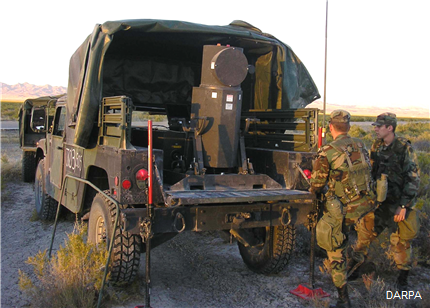Small, deep-UV lasers could detect biological and chemical agents on the battlefield
DARPA’s LUSTER program aims for handheld lasers that would allow soldiers to detect dangerous substances from a distance.
The ability to detect chemical and biological agents on the battlefield would go a long way toward reducing threats to soldiers. But the systems the Defense Department currently has — ultraviolet lasers that can identify unknown substances via Raman spectroscopy — are too large, expensive and power-hungry for field use.
The Defense Advanced Research Projects Agency is looking to solve that problem with the development of a compact, efficient, high-powered ultraviolet laser that can detect biological and chemical signatures.
DARPA recently held a proposer’s day workshop aimed at developing the Laser UV Sources for Tactical Efficient Raman (LUSTER) program, bringing together industry, academia and government to promote discussion regarding the program. DARPA began soliciting research proposals for UV laser technology on Mar. 13.
The goal of the LUSTER project is to develop UV lasers that are more than 300 times smaller than current generation lasers and 10 times more efficient. These lasers would then be integrated into current and future detection sensors.
“Today’s standoff detection systems are so large and heavy that trucks are required to move them,” DARPA program manager Dan Green said. “LUSTER seeks to develop new laser sources for breakthrough chemical and biological agent detection systems that are compact and light enough to be carried by an individual, while being more efficient than today’s systems. We also want to take a couple of zeroes off the price tag.”

DARPA wants to put the accuracy of laser systems such as the Joint Biological Stand-Off Detection System into a compact, portable form.
DARPA is looking for anything that can operate within a 220-240 nanometer wavelength range and have greater than 1 watt of power production, line widths of less than 0.01 nanometers, and wall-plug efficiencies greater than 10 percent.
Current deep-UV lasers such as excimer laser technology were invented in the 1970s and have been used in laser eye surgery and micromachining, according to Defense One. The smallest ones are desktop sized -- still too large for the military, which is looking to develop extremely compact lasers.
Compact lasers would serve a variety of applications, including the remote detection of biological and chemical compounds, increasing the viability of compact atomic clocks, and be used for point-of-need medical diagnostics. These lasers would be able to detect chemicals and agents at a range of up to 10 meters, and be easily carried by a soldier.
LASER is intended to improve on of DARPA’s Compact Mid-Ultraviolet Technology program, which developed high-powered UV LEDs with high efficiencies and wavelengths but which lack the sensitivity to identify chemical compounds. The goal of LUSTER is to develop a system that combines the accuracy of high-powered lasers with the reliability and low cost of LEDs, DARPA said.
NEXT STORY: Watch: Big Dog robotic mule gets a head-arm




